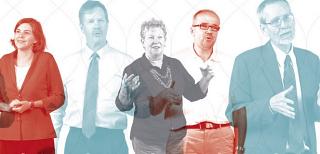
Faster, cheaper DNA sequencing is sparking optimism that cures are just around the corner. But to turn genetic data into knowledge that’s meaningful for patients, we need experts with wildly different skill sets to connect with one another. Here we highlight just some of the brilliant minds who are forging new paths to discovery.
The Connectors
Deborah Neklason, Ph.D., Research Associate Professor, Internal Medicine
Lynn Jorde, Ph.D., Chair, Department of Human Genetics
Astute specialists often make clinical observations that hint at genetic causes but lack the training or resources to act. “They need to be in an environment that encourages a research perspective,” says Deborah Neklason, Ph.D., program director for the Utah Genome Project (UGP). Neklason and Executive Director Lynn Jorde, Ph.D., spearhead efforts that link physicians and scientists with informaticists, epidemiologists and geneticists, and assist them in using a powerful resource – the Utah Population Database – to find what they’re looking for. In two years, UGP research has, so far, identified new risk factors for preterm birth, heart arrhythmia, immunodeficiencies, breast cancer and the causes of three rare diseases, and developed new disease gene identification tools. Each success helps build a pipeline from DNA to diagnosis. “It’s a great leap forward for science, for genetics, for medicine and for the quality of life for families,” says Jorde.
The Analysts
Gabor Marth, D.Sc., Professor, Human Genetics
Mark Yandell, Ph.D., Professor, Human Genetics
If predictions hold, and the number of new genomes sequenced grows 20-fold in the next three years, we’ll have a big problem on our hands – the capacity to analyze them. That’s the impossible problem that Gabor Marth, D.Sc., and Mark Yandell, Ph.D., co-directors of the USTAR Center for Genetic Discovery, are trying to solve. “We are building an information highway that will be able to transport huge amounts of genetic DNA information from the sequencing machine to the clinic,” says Marth, who earned his chops on the 1,000 Genomes and other heavyweight projects. The duo develops genomic analysis software tools such as VAAST, which is used by more than 250 institutions worldwide. They’re collaborating with industry to build a user-friendly, web-accessible platform to distill genomic data into clinically relevant findings. “Our goal is to be able to go from DNA to diagnosis within minutes,” says Yandell.
The Translator
Karen Eilbeck, Ph.D., M.Sc., Associate Professor, Biomedical Informatics
For all of their bright spots, computers are terrible at some things. Inference is one of them. If one scientist describes the location of a DNA variant as “chromosome 1” and another as, “chr 1,” computers won’t connect the dots. Multiply those kind of notation ambiguities by 3.5 million – the average number of variants in a person’s genome – feed them into software, and the result is a total genetic mishmash. “We can’t communicate if we’re not using the same language,” says informaticist Karen Eilbeck, Ph.D., M.Sc. To rein in the free-for-all, Eilbeck is working with people from the CDC, clinical laboratories, software development, accrediting agencies and research communities to create a worldwide standard. “Misinterpretation poisons the data. We can’t afford to let that happen.”
The Scientist
Mario Capecchi, Ph.D., Nobel Laureate; Distinguished Professor, Human Genetics
Finding a genetic mutation is just the beginning of the scientific story. One of the longest chapters to come is figuring out how changes in DNA spell trouble within the body. “If you formulate the questions appropriately, the answers will come,” says Mario Capecchi, Ph.D., distinguished professor of human genetics. He received the 2007 Nobel Prize for inventing gene targeting in mice, a revolutionary technique used by researchers around the globe to test how mutations morph into disease – the first step in uncovering novel treatments. “No story is one gene. It’s always the interaction of many genes together. It has a beginning, a middle and an end,” Capecchi says. “My end is always understanding.” Push understanding – push basic research – and translation, he says, will follow.
